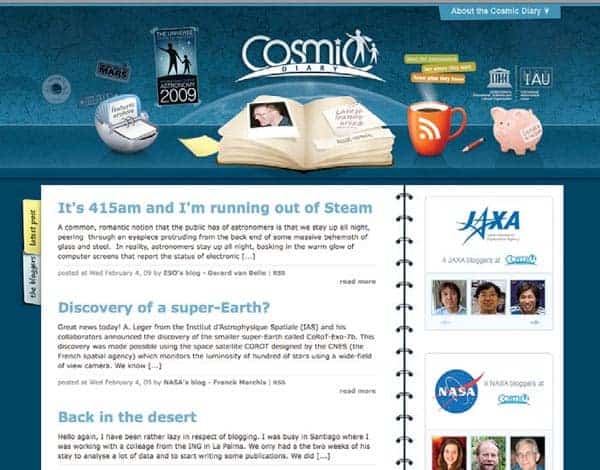URL: www.cosmicdiary.org

What is it?
Cosmic Diary brings together a smorgasbord of blogging astronomers from around the world, with more than 50 contributors commenting on new discoveries and long-standing questions in astronomy — as well as offering insights into their ordinary working lives and outside interests. The site is sponsored by the International Astronomical Union and UNESCO, and it is one of 11 “cornerstone projects” of the International Year of Astronomy 2009 (IYA2009).
Who writes the blogs?
Contributing authors range from Aude Alapini, a Belgian/Beninese astrophysics PhD student at the University of Exeter in the UK, to Brother Guy Consolmagno, curator of meteorites at the Vatican City Observatory. They are a truly international bunch, with over 30 countries and five continents represented, and most are in the early or middle stages of their careers, with a median age of just under 40. Almost half are women, a statistic that reflects a key goal of IYA2009, which is to support and promote women in astronomy. There are a few familiar names, including Alan Hale, co-discoverer of the comet Hale–Bopp (and now head of the Earthrise Institute, which promotes the use of space and astronomy as a bridge between cultures). But most are relative unknowns outside their field.
What topics do the blogs cover?
Some bloggers have chosen to focus on their own research and outreach work, while others offer an inside look at the “glamorous” life of an itinerant observer as they travel between their home institutions, conferences and telescope sites. Several writers have used Cosmic Diary to post their favourite photos of stars and galaxies, and many contain posts on news stories, astronomy-related or otherwise, including the inauguration of US President Barack Obama. A few bloggers from the developing world — such as Rogel Sese of the Philippines — have written about the challenges of doing astronomy in their home countries.
Who is it aimed at?
The project’s guidelines call for writers to use “easy-to-understand language to translate the nuts and bolts of their scientific research into a popular-science article”. Hence, the biggest beneficiaries of this mega-blog are likely to be non-astronomers working both within science and outside it. However, if you are looking for more technical details, do not give up — over the course of the year, each blogger will also write a “feature” article explaining their research in greater depth. Given the blog’s international flavour, it is worth noting that all entries are written in English, although several authors have elected to translate entries into their native languages as well.
How often is the blog updated?
A fair number of those involved in Cosmic Diary are new to blogging, and several have taken to it with the zeal of converts, posting a dozen or more entries in January alone. At the other end of the scale, a few blogs still contained no entries over a month into IYA2009 — although one of the latecomers, Serbian astrophysicist Tijana Prodanovic, made up for lost time with a humorous post about how holidays in her country follow the older Julian calendar, and hence IYA2009 did not really begin until 14 January.
Any advice on navigating through all these blogs?
Excerpts from the five most recent posts occupy the top half of the site’s main page, so it is easy to see at a glance who has updated their blog on any given day. Meanwhile, a sidebar contains links to blogs by authors who work for big organizations like the European Southern Observatory and the Japanese Aerospace Exploration Agency. This might be useful for readers who want to keep track of particular projects via the blog. The division between these blogs and the remaining “unaffiliated” ones can make flipping between entries confusing, however.
• You can also read the latest posts from Cosmic Diary at physicsworld.com



